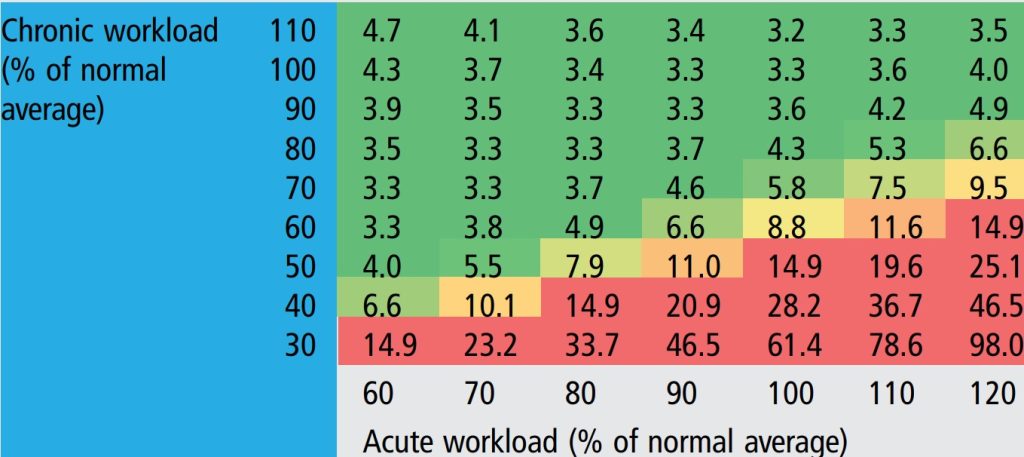
Want To Reduce Your Injury Risk By 50-66%? Here’s How.
For anyone who plays sport, and whatever level they play at, preventing injuries should always be part of the gameplan. From our weekend warriors & couch-to-5k beginners, through our recreational competitors and up to our elite athletes, avoiding injuries is something we should all put some time and effort into. The good news is that research shows we can reduce acute sports injuries (i.e. a single event like a sprain or strain) by almost 66%, and almost halve overuse-type injuries.
Why Focus On Injury Prevention?
Ok, this might seem like an obvious question, but there are more reasons to prevent injuries aside form just avoiding pain. Being injured is frustrating because it may mean you have to reduce or completely miss training and competition. This is especially annoying if you’ve been training hard for a big game or a race, then you have to miss it or can’t perform at your best. Plus, if it’s a team sport, many people feel they are letting their team-mates down and missing out on the social side of sport. For elite athletes, their livelihoods and future career may be risk.
Another side-effect of missing your regular training for a while is the increased risk of picking up another injury when you get back. Put simply, if you have to reduce your training for a while to recover from one injury, then when you get back you are at a greater risk of sustaining another injury.
This table is taken from an article by Blanch & Gabbett1 and shows how much your risk of injury is increased after a period of reduced training. For example, if you are injured and have to reduce your training to only 40% of your normal load for 4 weeks to recover, then if you try to go back to 100% of your normal training straight away then you are 28.2% more likely of being injured again. This is a great reason to put some effort into preventing an injury from happening in the first place.

Another reason to focus on preventing injuries is to improve your chances of having a successful season. Research on elite Australian runners2 showed that runners who completed >80% of their planned training weeks had a 7-fold increase in their chance of achieving their performance goals. While this research looked at elite athletes (which most of us aren’t!), the general principle holds true for recreational sports people as well: being able train consistently will dramatically increase your ability to be able to play or compete at your best, whatever your level of competition.
And finally, another reason to work on injury prevention is to avoid the time, inconvenience and cost of treatment and rehab. We believe that most people, if they knew that they could halve their injury risk by doing strength training, would rather put their time and money into preventing injuries rather than treating them. The problem is that most people aren’t aware of how effective strength training can be in preventing injuries. So, lets see just how helpful it can be.
Strength Training Reduces Injuries
The most comprehensive research review available3 looked at 25 studies which included 26 610 individuals and 3464 injuries. They included participants of all levels of competition, from recreational to elite. They also covered adolescents as well as adults.
This review showed that “Strength training reduced sports injuries to less than 1/3 and overuse injuries could be almost halved.” They found that strength training was more effective than mixed training programs (which included proprioceptive exercises as well as strength) at reducing injuries. This does not mean that strength exercises should be the only type of exercise involved in your strength and conditioning program, but it does indicate that strength training should form the basis your program to reduce injuries.
Put simply, the findings strongly support the principle that the stronger you are, the less likely you are to get injured. Perhaps the surprising part is exactly how much protection you get by being strong. With acute injuries like sprains and strains being reduced to only 1/3, and overuse injuries being almost halved, this study really highlights the protective effect of strength training
What about Stretching?
Research, including the article discussed above3, has consistently shown that stretching does not help reduce injuries. This doesn’t mean that it is not useful in other ways, for example ensuring you have enough mobility to perform your sport with correct technique, but it just wont help you avoid injuries.
How Much Strength Training Is Needed?
Follow-up research4 by the previous authors found that there is a dose-dependent effect of strength training, i.e. the more strength you gain, the more protective effect it has. They found that a 10% increase in strength training volume reduced the risk of injury by more than four percentage points. The optimal frequency, intensity and type of strength training will vary from person to person, but their results show that, as a principle, the stronger you are the less likely you are to get injured.
The authors also highlighted the need for the strength program to be properly prescribed, individualised, periodised, and progressed. This includes an initial “familiarisation/technique phase prior to gradual volume and intensity progressing phases… Preliminary phases may seem irrelevant to eager athletes/clubs, however we consider the initial phases of injury prevention to be a critical investment.” They noted that “no adverse effects due to the strength training program were reported”. This shows that when properly prescribed and executed, strength programs are safe as well as very effective in reducing injuries.
How Does Strength Training Protect You From Injuries?
The Effect Of Strength Training On Muscles
Strength training increases the strength and resilience of many of our body’s tissues. Muscle mass, strength & power are increased, and it is thought that our ability to co-ordinate muscle contractions is improved by strength training. This combination of better co-ordinated and stronger muscle contractions reduces the risk of musculoskeletal injuries both within the muscle, and also of other structures like our joints, because our ability to stabilise and control movement is improved.
The Effect Of Strength Training On Bones
Strength training also reduces our risk of bone injury5. Although bone responds positively to various types of training, resistance training provides the greatest osteogenic (increase in bone mineral density) effect. So, strength training increases our bone strength as well as our muscle strength. One of the biggest benefits of this is that strength training can reduce the incidence of stress fractures in our lower bodies. This is especially important for middle-long distance runners, as well as many other sports that involve repeated running and jumping.
The Effect Of Strength Training On Connective Tissue
Connective tissue provides the support framework for our body. In this discussion we are mostly talking about our ligaments, tendons and cartilage. Collagen is the main component of these types of connective tissue, and strength training has been shown to increase the collagen content in these tissues to produce an increase in their size and strength5. The increase in collagen is proportional to the size of the muscle, so increasing muscle mass through strength training also increases the size and strength of the associated connective tissue. This is thought to be the mechanism for the reduced injury rates in these tissues following strength training programs.
So, What’s The Right Strength Program For You?
This discussion highlights how effective strength training can be in reducing injuries, but which program is best for you? Well, that depends on lots of things like;
– your current levels of strength and fitness
– which sport you play and at what level (strength training has been shown to be just as beneficial to casual/recreational sportspeople as elite athletes)
– any injury history you may have
– the relative strength and mobility of different areas of your body (this needs to be determined in an initial assessment)
– your previous experience and exposure to strength training
Building strength consistently over time involves frequent adjustments of weight, and also exercise progression (i.e. which exercises you do in each session). Errors in exercise selection or weight progression can mean that you don’t get the results you want, or injuries can be caused due to overloading (which is the exact opposite of the aim of the program!).
We take The Guesswork Out Of Getting You Strong
We work with clients every day helping them to get stronger, avoid injuries and improve their physical health and performance. Our personalised programs are tailored for clients of all fitness levels, and for training beginners through to experienced gym goers. Our speciality is returning clients to their full level of fitness following an injury or a break in exercise due to lifestyle reasons.
Our experienced strength coaches are either accredited exercise physiologists or physiotherapists with advanced training in strength exercise prescription. We take the guesswork out of your program by completing a thorough initial assessment with you, then setting out your detailed program so you know exactly what to do, how much, and with correct technique. Each session is adjusted according to your current ability, and you will really get to feel and see your progress over time.
Meet Our Strength Coaches

Chris McCarthy, Head Of Exercise Physiology
As an Exercise Physiologist I get great joy from watching my clients achieve their goals through exercise whilst building lasting relationships with them. I enjoy the challenge of providing targeted, effective and stimulating exercise programs to prevent injury, increase resilience, and maximise the ability of my clients to consistently perform at their best.

Zach Allen, Accredited Exercise Physiologist, Strength & Conditioning Coach
I am an ESSA accredited Exercise Physiologist and Exercise Scientist, graduating with a Bachelor of Clinical Exercise Physiology (Honours) at the University of Queensland. After graduation I worked in Brisbane as an Exercise Physiologist treating a wide variety of clients ranging from athletes to those needing exercise to improve their all-round health or manage chronic disease.
During this time I also became the Head of Performance at Mount Gravatt AFC. This involved designing and delivering strength and conditioning programs for improving athletic performance as well as recovering from injury. This is where my passion for strength and conditioning for runners and other athletes really took off, and I gained extensive experience integrating strength training for both performance improvement as well as injury prevention.
Being a firm advocate for the role of exercise as a management tool for chronic health conditions, together with years spent battling my own sporting injuries, has consolidated my love for injury prevention and a strong desire to improve quality of life for all.
Would You Like Help With Your Strength Program?
If you are ready to get started on building your strength and fitness then we’re here to help. For more information or to book your first session please call us on 9280 2322. You can also click below to email us a question, ask for a call-back from one of our coaches to discuss how we can help you, or to request a booking.
REFERENCES
1. Blanch, Peter & Gabbett, Tim. (2015). Has the athlete trained enough to return to play safely? The acute:chronic workload ratio permits clinicians to quantify a player’s risk of subsequent injury. British journal of sports medicine. 50. 10.1136/bjsports-2015-095445
2. Raysmith, Ben & Drew, Michael. (2016). Performance success or failure is explained by weeks lost to injury and illness in elite Australian Track and Field athletes: a 5-year prospective study. Journal of Science and Medicine in Sport. 19. 10.1016/j.jsams.2015.12.515.
3. Lauersen JB, Bertelsen DM, Andersen LB. (2013) The effectiveness of exercise interventions to prevent sports injuries: a systematic review and meta-analysis of randomised controlled trials Br J Sports Med 2014;48:871–877
4. Lauersen JB, Andersen TE, Andersen LB. Strength training as superior, dose-dependent and safe prevention of acute and overuse sports injuries: a systematic review, qualitative analysis and meta-analysis Br J Sports Med 2018;52:1557–1563.
5. Hoffman, J. (2017) Resistance Training and Injury Prevention. Indianapolis, IN: American College of Sports Medicine

